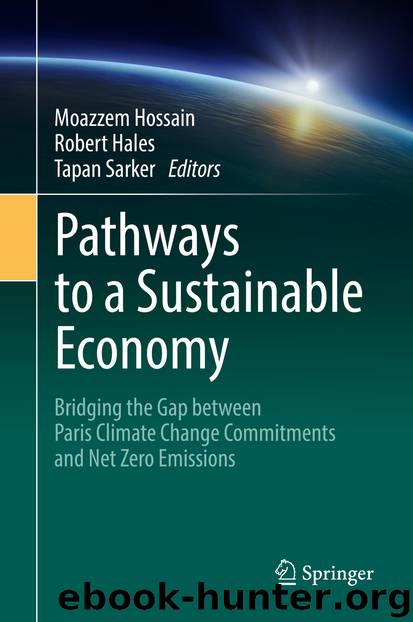Pathways to a Sustainable Economy by Moazzem Hossain Robert Hales & Tapan Sarker

Author:Moazzem Hossain, Robert Hales & Tapan Sarker
Language: eng
Format: epub
Publisher: Springer International Publishing, Cham
Interruptions or reversals of the fertility transition, such as those in Egypt and Indonesia, are not accommodated in the UN’s population model (O’Sullivan, 2016). The UN’s medium projection continues to expect the downward trend in global increment to resume, based on immediate resumption of fertility decline in all high-fertility countries, despite many of them seeing little if any decline recently. As shown in Fig. 7.3, data on actual change in global population, reported annually by the Population Reference Bureau (PRB, 2011–2016), are greatly exceeding the “medium” projection and instead are approximating the “constant fertility” projection, which assumes all countries continue with the same fertility they had in 2010. If sustained, it results in a global population of 28 billion by 2100. Of course, such a population could not be fed—if fertility does not fall, then death rates must rise.
Yet, despite the poor track record of recent projections, most climate impact modellers continue to regard future population as predetermined. They do not consider what measures might be available to influence it. Most do not even acknowledge the uncertainty of population projections or consider any sensitivity analysis to see how emissions outcomes would be affected if population is higher or lower than expected.
Marangoni et al. (2017) attempted sensitivity analyses on the main drivers of FFI emissions in the SSP scenarios and concluded population growth was relatively unimportant compared with economic growth and energy intensity of the economy, although the latter two tended to offset each other. This outcome was a product of their methodology, which contrasted outcomes to 2050 in SSP2 projections when individual drivers were substituted from SSP1 or SSP3. Hence it highlighted whichever factors varied most in the short term between these three SSP scenarios, due to the arbitrary assumptions underlying those scenarios. They failed to acknowledge that energy intensity of the economy and growth in GDP per capita are not independent factors but tend to offset each other—increasingly so as energy constraints intensify in the future. In most cases, if a higher assumption is imposed about future economic growth, a lower energy intensity is required to achieve it, so that the net effect is predictably smaller than the individual effects. The effect of population was further understated by omitting land use emissions and biomass sequestration.
In contrast, sensitivity analyses based on historical data have found population growth to be a stronger driver of emissions than economic growth. The studies of Jorgenson and Clark (2010), Casey and Galor (2017), O’Neill et al. (2010) and Bajželj et al. (2014) have already been mentioned. Alexander et al. (2015) found that population growth has been the largest driver of land use change, although dietary changes in emerging economies are an increasingly important contributor. The World Resources Institute’s exemplary series Creating a Sustainable Food Future found that achieving replacement level fertility in sub-Saharan Africa by 2050 would spare an area of forest and savannah larger than Germany from conversion to cropland, and in doing so save 16 Gt of carbon dioxide emissions (Searchinger et al., 2013).
Download
This site does not store any files on its server. We only index and link to content provided by other sites. Please contact the content providers to delete copyright contents if any and email us, we'll remove relevant links or contents immediately.
International Integration of the Brazilian Economy by Elias C. Grivoyannis(92243)
The Radium Girls by Kate Moore(11935)
Turbulence by E. J. Noyes(7944)
Nudge - Improving Decisions about Health, Wealth, and Happiness by Thaler Sunstein(7622)
The Black Swan by Nassim Nicholas Taleb(7016)
Rich Dad Poor Dad by Robert T. Kiyosaki(6414)
Pioneering Portfolio Management by David F. Swensen(6231)
Man-made Catastrophes and Risk Information Concealment by Dmitry Chernov & Didier Sornette(5926)
Zero to One by Peter Thiel(5694)
Secrecy World by Jake Bernstein(4653)
Millionaire: The Philanderer, Gambler, and Duelist Who Invented Modern Finance by Janet Gleeson(4386)
The Age of Surveillance Capitalism by Shoshana Zuboff(4216)
Skin in the Game by Nassim Nicholas Taleb(4166)
Bullshit Jobs by David Graeber(4104)
The Money Culture by Michael Lewis(4083)
Skin in the Game: Hidden Asymmetries in Daily Life by Nassim Nicholas Taleb(3935)
The Dhandho Investor by Mohnish Pabrai(3706)
The Wisdom of Finance by Mihir Desai(3659)
Blockchain Basics by Daniel Drescher(3511)
